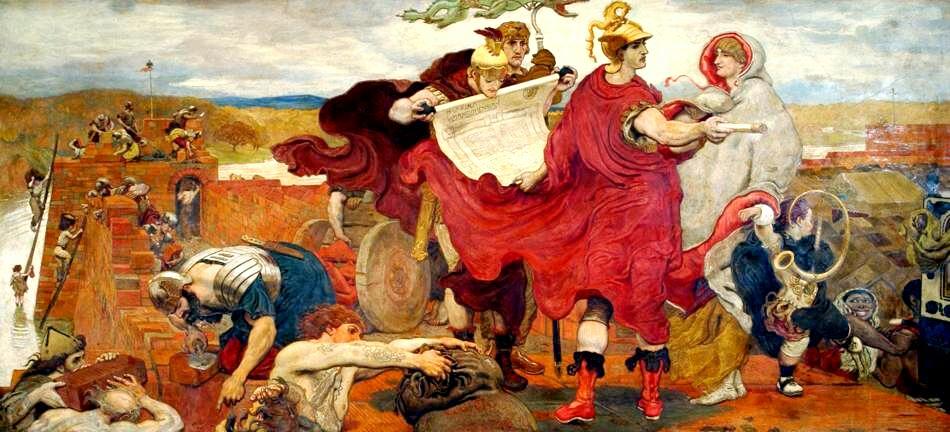
Britania: Roman Cities (1st-3rd centuries AD)

Figure 1.--There were no cities in Britania before the arrival of the Roman Legions. Urban life was a Roman innovtion. And this began with the Romans building forts. Most of England's major cities, inluding London, began a a Roman fort. "The Romans Building a Fort at Mancenion" was painted by Ford Madox Brown, one of his Manchester Town Hall murals. The mural depicts the building of one of these forts by enslaved Britons directed by a Roman general. The fort, now known as Mamucium, was at what is now the area of Castlefield, near the center of Manchester.
|
|
There were no cities in Britain before the arrival of the British. The Celts hadbegun to form larger settlements that were developing in to cities in Gaul at the time of the Roman coquest (1st century BC). This process was at a more limited phase in Britin. The Celts were farmers. They intriduced the iron plough to farming which increased yiels and would have eventually led to the same irbanization that had begin in Gaul as the Rpmns arrived. In Britania we see some larger villages beginning to aear but there were not yet much in the way of towns, let alone cities. What we do see in Celtic Britania was a substantial number of hill forts. Forts may be an exageration. They were basically small ditch and bank combinations built to defend hilltops. Some were so small that they must have been built by single or small group of families. Many larger forts were built. Archeologists are ot sure who built these hill forts. Some believe that the ere built by the native Britons to defend themselves from the advancing Celts. Others believe the Celts built them. As they were hill top constructions, they usually had no source of water. This suggests that ghey were not long term settlements. They may have been refuges able to withsnd xa short seige. Many were built over older causewayed camps. The Roman army as they advnced nrthward in Britania, built substantial forts throughout Britain. Some were temporary emplacements. Others forts became the beginning of the major cities of Roman Britain. Most important English citiesbegan as a Roman fort. The forts at places like Londinium have been largely destroyed by urban development over time, although thereare Roman remains in London, including a burried colliseum. The forts that did not become urban centers have proven to be valuable sources of information. One example is the fort at Ribchester. Almost from the beginning the Romans began constructing roads connecting these forts. The salaries paid the soldiers from an early period began attracting Celts willing to perform services of value to the soldiers and Roman officials. This included artisans, bakers, laborors, launderers, smiths, and many others. These people at first settled outside the Roman forts. The forts and Celtic selllements developed into cities. These Celts over time became Romanized to varying degrees.
CIH

Navigate the Children in History Website:
[Return to the Main Roman Britain page]
[Return to the Main Roman page]
[Return to the Main ancient civilization page]
[Return to the Main British history page]
[Return to the Main Scottish history page]
[Introduction]
[Biographies]
[Chronology]
[Climatology]
[Clothing]
[Disease and Health]
[Economics]
[Geography]
[History]
[Human Nature]
[Law]
[Nationalism]
[Presidents]
[Religion]
[Royalty]
[Science]
[Social Class]
[Bibliographies]
[Contributions]
[FAQs]
[Glossaries]
[Images]
[Links]
[Registration]
[Tools]
[Children in History Home]
Created: 1:47 AM 1/15/2018
Last updated: 1:48 AM 1/15/2018



